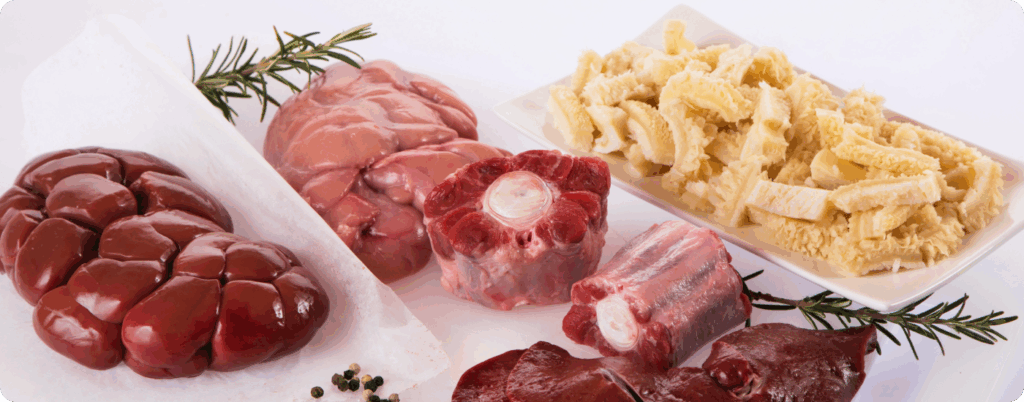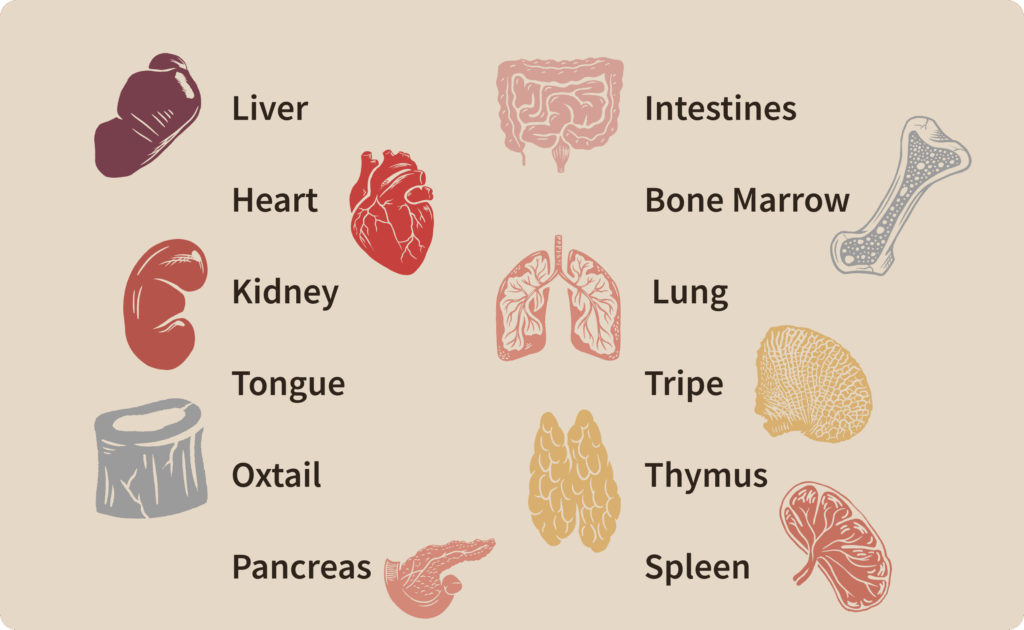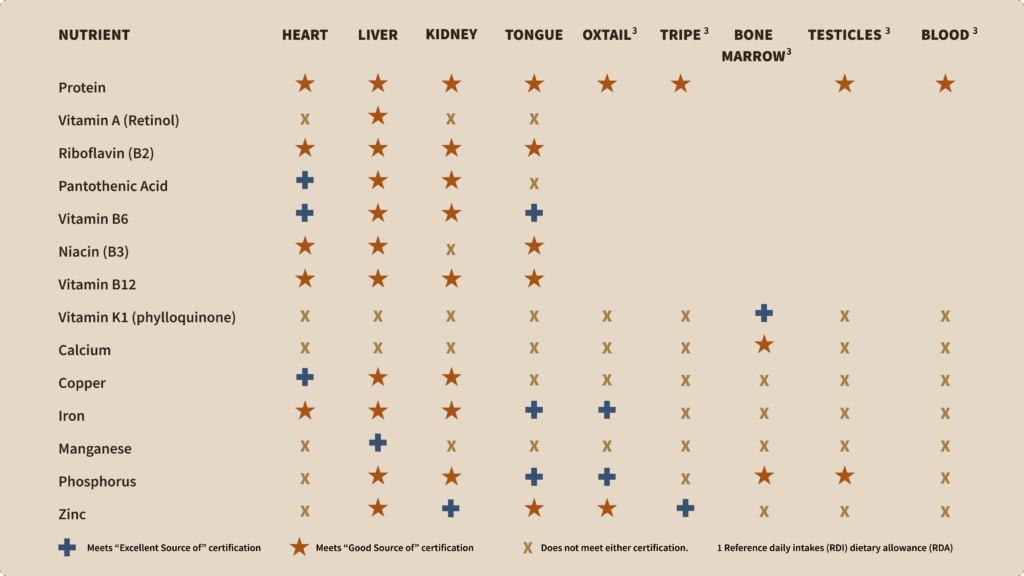PLEASE NOTE: The information in this blog is for educational purposes only. It is not a substitute for professional medical advice. Consult your healthcare provider if you’re seeking medical advice, diagnosis, or treatment.
In today’s health-conscious world, millions of people are looking for nutrient-dense foods that can optimize their well-being. While “superfoods” like kale and greens powders get most of the attention, there’s an incredibly nutritious category of foods that most modern diets have abandoned: offal.
Once prized by our ancestors and still celebrated in traditional cuisines worldwide, offal represents some of the most nutrient-dense foods on the planet. Yet despite their exceptional nutritional profile, organ meats remain underutilized in modern diets, representing a significant missed opportunity for optimal health.

In this article, we’ll explore the question of “what is offal?” and better understand why organ meats are making a massive comeback.
What is Offal?
Offal refers to the edible internal organs and other parts of animals that are typically discarded in modern meat processing. The most common types of offal are:
- Liver
- Heart
- Kidney
- Tongue
- Brain
- Tripe (stomach lining)
- Testicle
- Bone Marrow

These organs (and numerous others) have been consumed by humans for millions of years (1), with our ancestors often prioritizing organ meats over muscle meat due to their superior nutritional density.
Unlike most modern diets, indigenous populations worldwide understood the value of these different offal cuts (2). Weston A. Price documented how Eskimos of Alaska made liberal use of organs and special tissues from sea animals, while Native Americans in the Rocky Mountains emphasized eating animal organs, often feeding the muscle meat to their dogs instead.
This ancestral wisdom recognized what modern science now confirms: organ meats are nutritional powerhouses that can far exceed the nutrient density of conventional muscle meats (3).
Offal Health Benefits
While the nutritional value of offal can vary based on the specific organ, these foods represent some of the most bioavailable sources of essential nutrients, meaning your body can readily absorb and utilize them. Here are 3 main reasons why offal can be so powerful.
Vitamins & Minerals
A variety of studies have shown that offal is a significant source of critical vitamins and minerals (4). A study from 2024 noted that various organ meats can be considered an “excellent” or “good” source of protein, vitamin A, B vitamins, and other important nutrients (5).

For example, about 3 ounces of liver (100g) can satisfy up to 50% of the recommended daily intake for B vitamins, zinc, iron, and selenium (6). Plus, this small amount of liver can fulfill 100% of the recommended daily vitamin A intake.
Many of the minerals found in organ meats (such as selenium and zinc) can counteract free radicals which can damage cells and cause oxidative stress (7). The protein, vitamin, and mineral content of organ meats is also often higher than muscle meat (8, 9).
Unique Compounds
Aside from vitamins and minerals, edible organs contain numerous bioactive compounds rarely found in other foods. These include Coenzyme Q10 (CoQ10), which is essential for cellular energy production and acts as a powerful antioxidant (10).
Organ meats also provide taurine, creatine, carnosine, and various bioactive peptides with antihypertensive, antimicrobial, and antioxidant properties (11).
Potential Health Benefits
Nutrients found in organ meats may help to improve energy levels, immune health, skin health, cognitive function, and sperm count, and have even been used to overcome nutrient deficits (12, 13, 14). Various studies have also used beef liver to help improve or eliminate anemia (15, 16).
4 Easy Ways to Add Offal To Your Diet
Even with their nutrient density, many people are hesitant to incorporate organ meats into their diets due to unfamiliarity, concerns about red meat, or taste preferences. However, there are numerous practical ways to begin including these nutritional powerhouses in your meals.
1. Start Simple
Begin with milder-tasting organs like heart, which has a texture similar to muscle meat but with added nutritional benefits. Beef heart is a bioavailable source of protein, vitamin A, B vitamins, vitamin E, and vitamin K2 (17).

You can also try pork offal, lamb offal, and beef offal to figure out which is most appealing to you.
2. Buy Organ Blends
You can also incorporate organ blends into your routine. Companies such as Force of Nature and many local ranchers offer blends made with ground beef, liver, and heart. These are much more approachable taste-wise and can be used to make nutrient-dense burgers, meatballs, and various other recipes.
3. Try Traditional Recipes
Eating offal doesn’t have to be boring. Another strategy is to look to traditional cuisines for inspiration and delicious ways to incorporate offal dishes into your diet.

For example, Mexican cuisine features various organ meats in dishes like tacos de lengua (tongue tacos), while French cuisine offers rich pâtés and terrines, sometimes made with chicken liver.
4. Use Supplements
If you don’t like the taste of organ meat or want to skip the preparation altogether, supplements are another amazing way to incorporate offal into your diet.
Heart & Soil offers over a dozen unique organ blends that are 100% sourced from regeneratively raised, grass-fed & finished cattle and free from hormones, pesticides and artificial ingredients.
Not only are they easy to use, but options like Beef Organs have received thousands of 5-star reviews, such as this one from Heather:

The Bottom Line: Offal is Making a Comeback
In a world of ultra-processed foods and nutrient-poor diets, organ meats stand out as superfoods that have nourished human health for eons.
Millions of people are now rediscovering what our ancestors understood, that offal represents some of nature’s most perfect foods, providing bioavailable forms of essential nutrients that our bodies desperately need.
Incorporating organ meats into your diet can take some getting used to, but the potential rewards are substantial. Whether you choose to start with mild tasting organ like beef heart, experiment with traditional recipes, or utilize supplements, adding offal to your nutrition regimen can dramatically enhance your health and well-being.
Subscribe to future articles like this: